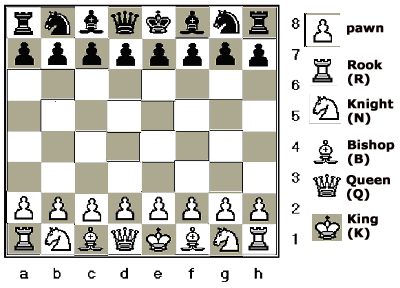Session # 3
REVISION- OF THE CLOCK, THE ALGEBRAIC NOTATION
Pour cette session, nous allons réviser ce qu'est la notation
algébrique, et l'utilisation du cadran.
A chess clock, has two clocks, one for each player, that is either digital
or manual. The player with the black pieces decides which side he wants
the clock (it's a way of balancing advantages because white starts the
game) . According to a time decided in advance, we adjust the clocks.
When all the time has ran out, there is a flag that falls, a light that
blinks or another sing that tells us that the time has ran out for one
of the player. The player that has ran out of time loses the game. As
an example, if two players decided
that they would have 15 minutes each to play the game, they would adjust
it like follows:
This way, when the 15 minutes has gone, the big arm of the clock would
push the red flag, and would make it fall back.
We are now going to learn how to record our game. The algebraic notation
is the way that is used to record the game. Every good chess board should
have letters in the bottom and numbers on the sides, with this we can
now give each individual square a letter and number to represent it,
like e4. Now If we can do the same with the pieces, we will be able
to say which piece moves on which square. The pawn doesn't have a letter
to represent it, the king, will be represented by: K , the Queen = Q,
the Bishop = B, the Knight = N, the Rook = R. We can now identify the
pieces and the squares with letter, numbers and symbols, we now need
symbol to represent if it's a movement, a capture, a check, check mate,
etc…
|
Symbol
|
definition
|
example
|
|
-
|
moves to
|
Qb6-d4
|
|
+
|
Check
|
Qb6-d4+
|
|
x
|
captures
|
Qb6xd4
|
|
mate
|
check mate
|
Qb6-d4 mate
|
|
:
|
promoted pawn
|
e8 : Q
|
|
?
|
Bad move
|
Qb6-d4 ?
|
|
!
|
Good move
|
Qb6-d4 !
|
|
*0-0
|
Small castle
|
0-0
|
|
*0-0-0
|
Big castle
|
0-0-0
|
|
*++
|
double check
|
Qb6-d4++
|
|
½ ½
|
Draw
|
Qb6xd4 ½ ½
|
|
0-1
|
White loses or resings
|
Qb6-d4 0-1
|
|
1-0
|
Black loses or resisngs
|
Qb6-d4 1-0
|
*These symbols are not important for now, but will be by the end of
the course.
Here is an example of how we prepare a sheet and how we write the game.
White: Joe
Black: Mark
Date: 12/09/2010
|
White
1. e2-e4
2. N-f3
3.
4.
5.
6.
7.
8.
9.
10.
(...)
|
|

Choose your session:
1
- 2 - 3
- 4 - 5
- 6 - 7
- 8 - 9
- 10 -
11 - 12
- 13 -
14 - 15
- 16 -
17 - 18
- 19 -
20 - 21
- 22 -
23 - 24
- 25 -
26 - 27
- 28 -
29 - 30
